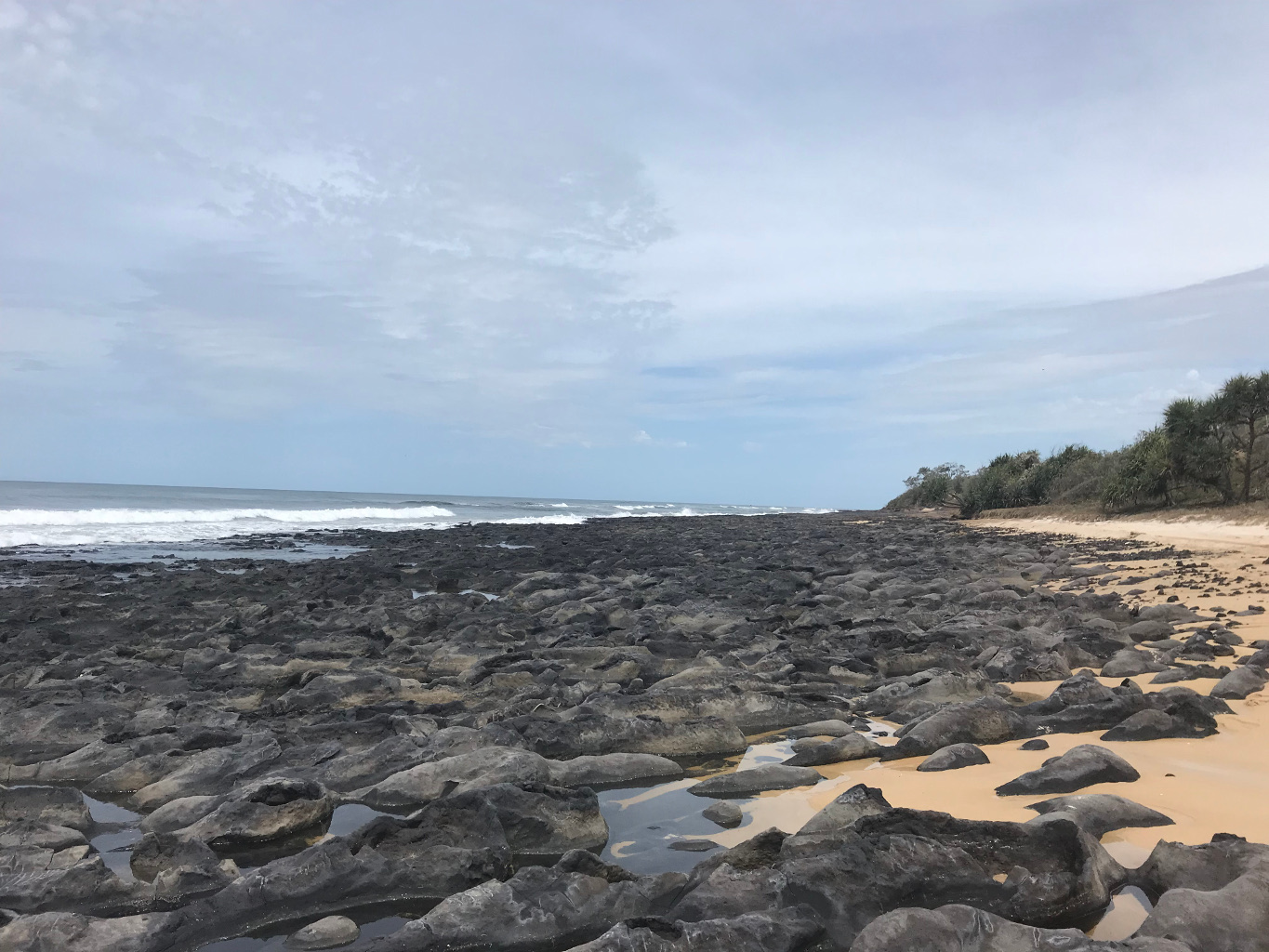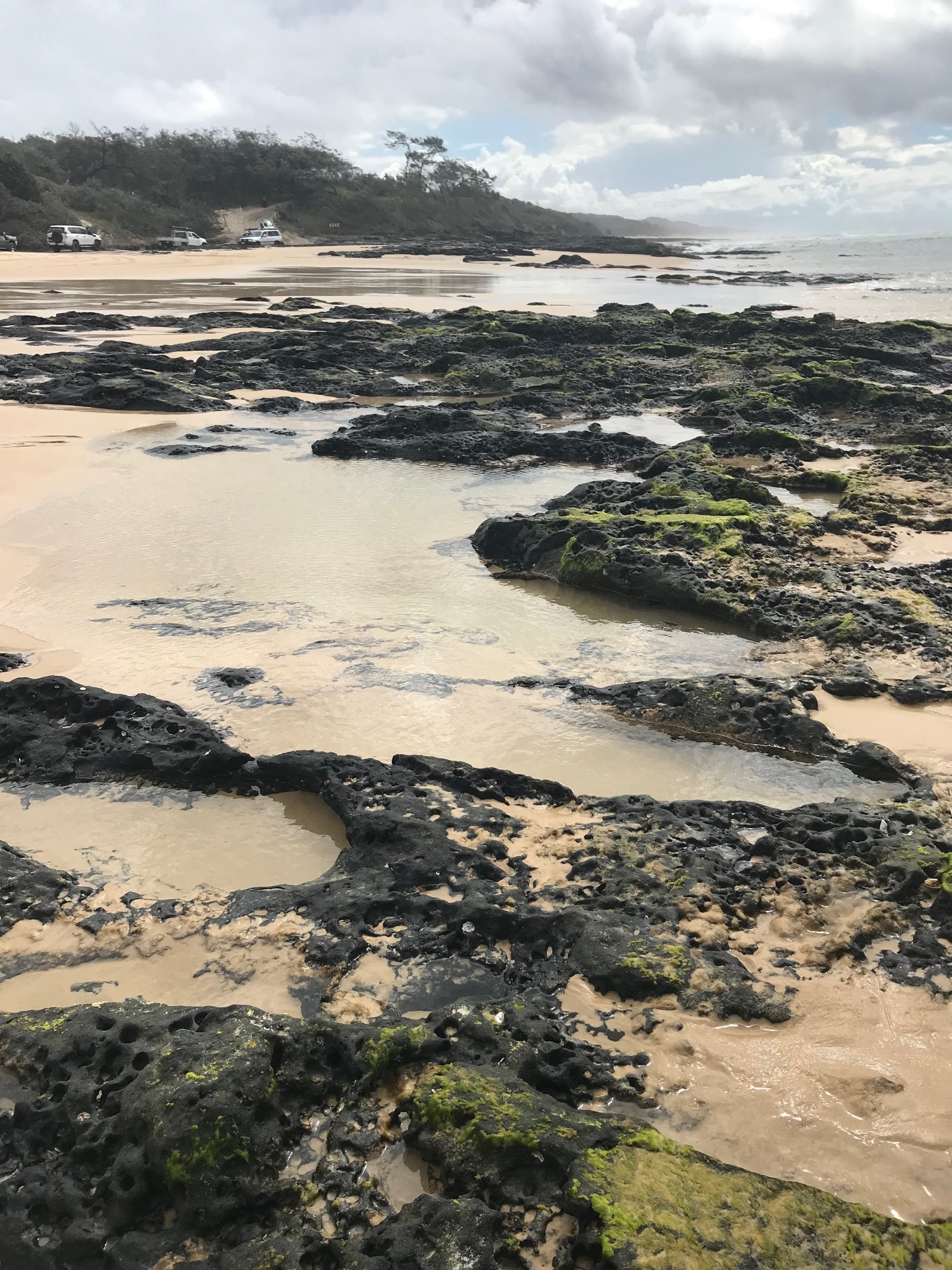|
|
Intertidal high energy over intermediate substrateShort descriptionIntertidal high wave energy over coffee rock on a sandy beach. Disclaimer: Ecosystem type descriptions are based on biophysical attributes identified in Central Queensland through expert advice and supported by scientific literature. Not all ecosystem types are mapped based on current inventory, and many of the ecosystems described here may also occur in other parts of Queensland.
Classification categoriesSelect from the links below to view related ecosystem type categories Long descriptionIntertidal very high to medium wave energy over coffee rock on a sandy beach, which is exposed and buried by sand deposition associated with wave action (e.g. storm events, cyclones, longshore drift). Often continuous with subtidal coffee rock, refer to type 101 (subtidal intermediate substrate including coffee rock). Coffee rock is a soft, dark-brown coloured friable rock consisting of sand grains weakly cemented together by organic matter (mostly plant-based). Coffee rock formed when humic acids from decaying plant matter are washed down through sandy soils, meeting shallow aluminium-rich groundwater where it precipitates to form an indurated sand layer in the B horizon of podzol soils. These occur on quartz sand systems in the sub-tropics and tropics[1]. On high energy shorelines it has become exposed by wave action against the sandy dune escarpment, outcropping on beaches and in the shallow subtidal area. Wave action can break up the soft rock into boulders by undermining the cliff face with coffee rock blocks dropping or sliding off the cliff face[3]. As it forms a hardened layer, coffee rock can be associated with groundwater discharge via freshwater seepage or springs draining through the sand dunes and then flowing sideways where it meets the low permeability rock (see Coastal sand masses (high dunes) conceptual model). Habitat forming biota other than green algae (e.g. Ulva sp. and other freshwater tolerant filamentous algae) seldom grows in pools in the coffee rock. Crabs may occupy the crevices within the rock (Moyra McRae pers. comm.). Special valuesProvides habitat for fish and other mobile fauna at high tide on an otherwise featureless shoreline. High energy coffee rock is associated with groundwater dependent ecosystems. Following high wave energy events, dense algal cover on coffee rock can provide important food source and habitat for herbivores. Diagnostic attributesInundation 'Intertidal – Lower low', 'Intertidal – Mid low', 'Intertidal – Upper low', 'Intertidal – Low undifferentiated', 'Intertidal – Lower medium', 'Intertidal – Upper-medium', 'Intertidal – Medium undifferentiated', 'Intertidal – High', 'Intertidal – Undifferentiated', 'Intertidal – High undifferentiated' Consolidation 'Intermediate' Energy magnitude (wave) 'Very high', 'High', 'Medium' QualifiersThe Naturalness qualifier is relevant as coffee rock is very soft and it is possible to scrape the surface or cut and remove it. Coffee rock is commonly encountered during beach driving where it becomes an obstacle to drivers, who in some instances have cut through coffee rock to gain beach access. Coffee rocks can be damaged by vandalism or graffiti. The Period and Trend qualifiers are also relevant as it can be alternately exposed and buried by sand after storms, cyclones, east coast lows and associated high energy wave action. (Moyra McRae pers. comm.). DistributionCoffee rock can be found up and down the Queensland coastline as a result of coastal processes and sea level change. High energy shorelines with coffee rock are found on K'gari (Fraser Island) and Cooloola southward, associated with high wave action along dunes of the large sand islands Bribie, Moreton and Stradbroke, and other coastal sand masses. Coffee rocks occur on sand masses further south in New South Wales (e.g. Broadwater Beach, Black Rocks), in New Zealand and overseas (e.g. South America). The following relates to distribution of this ecosystem type within the Central Queensland mapping area:
CommentsOther relevant attributes could include Substrate composition, Energy source, Energy magnitude and Lithology. The Terrain slope, Terrain roughness and Terrain morphology are indicative of cliffs, platforms, pools, crevices and other spaces as potential habitat for macroalgae and other biota. Associated with Lithology is the resistance of the rock to erosive processes and a Rock Mass Index has been used to measure this[3]. Additional Information
References
Last updated: 12 July 2019 This page should be cited as: Department of Environment, Science and Innovation, Queensland (2019) Intertidal high energy over intermediate substrate , WetlandInfo website, accessed 25 June 2024. Available at: https://wetlandinfo.des.qld.gov.au/wetlands/ecology/aquatic-ecosystems-natural/estuarine-marine/descriptions/25/ |

 — Department of Environment, Science and Innovation
— Department of Environment, Science and Innovation



